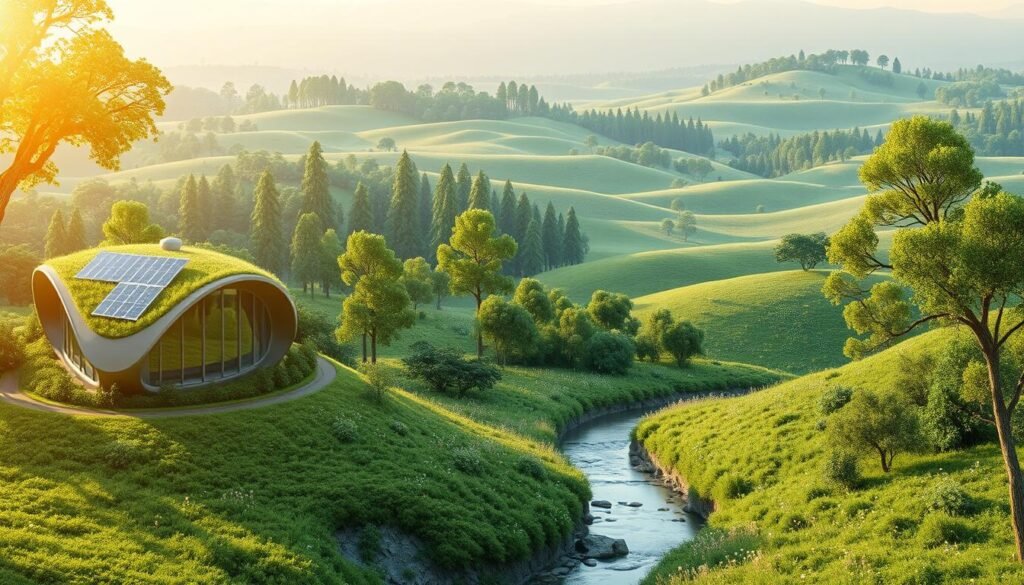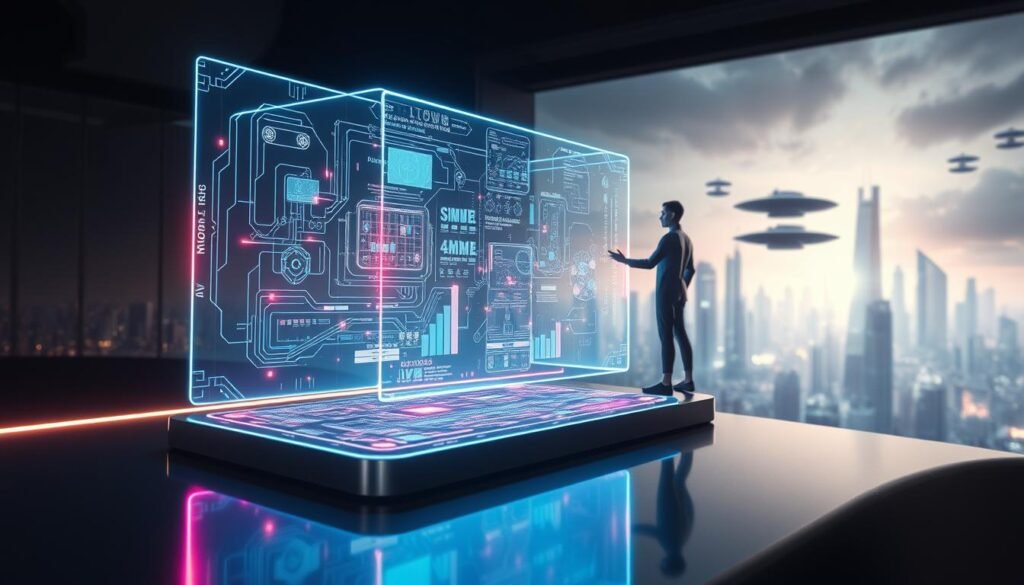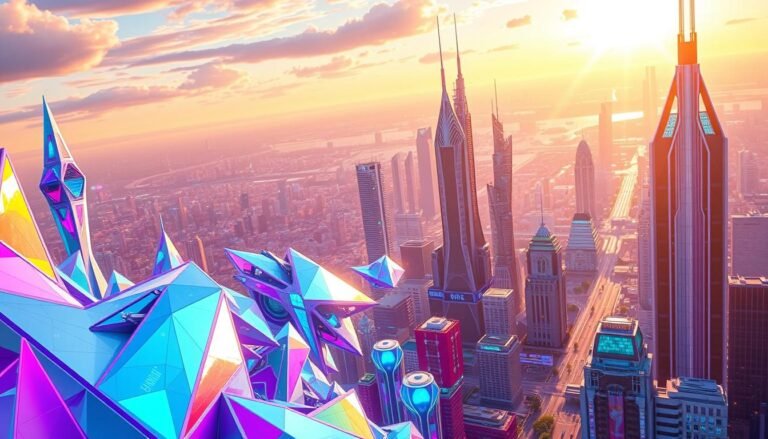The design world is always changing, and 3D illustration trends lead this evolution. As we enter 2025, designers are finding new ways to make their work come alive.
AI is making claymorphism and cartoon 3D more common and varied. For designers who aim to leave a mark, keeping up with these trends is key.
Let’s dive into the latest 3D illustration trends. We’ll see how these new ideas are changing design’s future.
Key Takeaways
- Discover the top 3D illustration trends of 2025
- Learn how AI is boosting design practices
- Explore the rise of claymorphism in modern design
- Understand the impact of cartoon 3D on visual storytelling
- Get insights into the future of 3D illustration
The Rise of Stylized 3D Illustrations in 2025
Stylized 3D illustrations are becoming more popular in 2025. They are changing the world of digital art. This is thanks to AI-enhanced design, which makes visuals more detailed and sophisticated.
What are Stylized 3D Illustrations?
Stylized 3D illustrations are not just realistic pictures. They focus on creativity and look. They often use glossy shading to make them more eye-catching.
Key Characteristics of Stylized Designs
Stylized 3D designs stand out with exaggerated features and bright colors. They also use Blender Cycles for advanced rendering. These features make the images striking and grab the viewer’s attention.
- Exaggerated features for enhanced visual appeal
- Vibrant color schemes to evoke emotions
- Advanced rendering techniques for realism and detail
Why They’re Gaining Popularity
Stylized 3D illustrations are getting more popular. They add depth and realism to designs while keeping them creative. AI-enhanced design makes it easier to create complex visuals, boosting this trend.
As designers explore new possibilities with stylized 3D illustrations, we’ll see more amazing designs. They will keep pushing the limits of what’s possible.
Bold Colors and Gradients: A Visual Revolution
Bold colors and gradients are leading a visual revolution in 3D design. They make the visuals more engaging and immersive. This trend is all about creating eye-catching visuals in a digital world full of them.
Effective Use of Colors in 3D
Using colors in 3D illustration is all about how they make us feel. Bold colors can make us feel excited and full of energy. On the other hand, softer colors can calm us down. Designers aim to pick colors that match what they want to achieve.
Colors can also highlight certain parts of a 3D scene. By using contrasting colors, designers can lead our eyes through the scene. Plus, PBR (Physically Based Rendering) textures make 3D models look more real by simulating how light works on real materials.
The Impact of Gradients on User Experience
Gradients are key in 3D design, adding depth and complexity. They help make 3D models look more real and engaging. By using gradients wisely, designers can guide our attention to important parts of the illustration.
Gradients also make 3D illustrations look better. By picking the right colors, designers can create a visual experience that people enjoy. Gradients can also help explain information and guide us through the illustration, making it better for us.
Minimalism Meets Maximalism in 3D Art
Minimalism and maximalism are now coming together in 3D art for 2025. This mix creates a new way to see things. It balances simple and complex, giving designers a new space to play.
The Balance Between Simplicity and Complexity
Combining minimalism and maximalism in 3D art is all about finding a balance. Minimalism makes things clear and focused, removing what’s not needed. Maximalism adds depth and color, making designs rich and engaging.
Key elements of this balance include:
- Using simple shapes and clean lines as the foundation
- Incorporating complex textures and detailed patterns
- Balancing monochromatic color schemes with bursts of vibrant colors
- Employing negative space effectively to guide the viewer’s eye
This mix is seen in character mascots in 3D art. These mascots have simple shapes but detailed designs. They are both easy to recognize and fun to look at.
Favorite Examples of This Trend
Designers are already playing with this trend, making amazing things. For example, they’re using character mascots with simple designs but lots of details. These mascots are used in branding and animation.
| Design Element | Minimalist Approach | Maximalist Approach |
|---|---|---|
| Shape | Simple geometric forms | Intricate, detailed structures |
| Color | Monochromatic or limited palette | Vibrant, multi-colored gradients |
| Texture | Smooth, flat surfaces | Complex, layered textures |
This trend will likely change design in many ways, from ads to movies. By mixing minimalism’s simplicity with maximalism’s depth, designers can make 3D art that grabs your attention and stays with you.
Eco-Friendly and Sustainable Designs
The world is getting greener, and so is 3D art. Designers are now more focused on being kind to the planet. This change is seen in the rise of sustainable 3D illustrations.

Importance of Sustainability in 3D Art
Sustainability in 3D art helps reduce its environmental harm. Designers use eco-friendly methods to cut down on waste and energy. This makes their work better for the planet and attracts eco-aware customers.
Eco-friendly designs use recycled materials and energy-saving software. Designers can pick digital tools that use less power or materials that can be recycled or break down naturally.
👉 get inspired by this : Sustainability in 3D
Materials and Techniques for Eco-Friendly Illustrations
To make eco-friendly 3D illustrations, designers choose the right materials and methods. Some ways include:
- Using software that is optimized for energy efficiency.
- Choosing materials that are recyclable or biodegradable.
- Implementing rendering techniques that reduce energy consumption.
- Incorporating UI hero graphics that are designed with sustainability in mind, such as simple, minimalist designs that require less computational power.
By using these methods, designers can make amazing 3D illustrations. These not only wow people but also help make the world a greener place.
Interactive 3D Designs: Engagement at Its Best
Interactive 3D designs are changing how we enjoy digital content. They offer deep, immersive experiences. This move towards interactivity is more than a trend; it’s a big step forward in how designers connect with their audience.
Benefits of Interactivity in Design
Adding interactivity to 3D designs has many benefits. It boosts user engagement and makes experiences more memorable. For example, cartoon 3D elements can make complex info fun and easy to grasp.
Interactive 3D designs are great at sharing information in a lively way. This is super helpful in education, where they can help students grasp tough topics more easily.
Tools for Creating Interactive Graphics
Designers use many tools to make interactive 3D graphics. Blender Cycles is a top choice for creating realistic and interactive 3D models.
Here are some key tools for interactive 3D designs:
- Blender Cycles for rendering and animation
- Three.js for creating interactive 3D content in the browser
- Unity for developing interactive 3D applications and games
These tools help designers create amazing, immersive experiences. They keep users engaged and interested.
| Tool | Primary Use | Key Features |
|---|---|---|
| Blender Cycles | Rendering and Animation | Realistic rendering, animation tools |
| Three.js | Interactive 3D Content | Browser-based, interactive 3D models |
| Unity | 3D Application and Game Development | Cross-platform, high-performance rendering |
Nostalgic 3D Aesthetics
The trend of nostalgic 3D aesthetics is big in 2025. Designers are going back to retro and vintage styles. This brings a sense of nostalgia to their work.
Nostalgia is a powerful tool in design. It lets creators connect with people’s happy memories. By using retro and vintage elements, designers make their work feel familiar and warm.
Exploring Retro and Vintage Styles
Retro and vintage styles are known for their unique looks. They use glossy shading, bold colors, and classic fonts. These features bring a nostalgic feel, like stepping back in time.
To add retro and vintage touches to 3D illustrations, designers have several methods. They can:
- Choose retro colors and textures
- Use vintage fonts and graphics
- Add glossy shading for depth and realism
Integrating Nostalgia into Modern Designs
Mixing nostalgia with modern designs is a fine art. Designers need to balance retro touches with today’s styles. They must make sure the nostalgic parts don’t overpower the design.
One way to find this balance is by blending retro elements with modern techniques. For example:
| Retro Element | Modern Technique | Result |
|---|---|---|
| Vintage typography | 3D modeling | Enhanced visual appeal |
| Retro color palettes | Gradient mapping | Increased depth and dimension |
| Glossy shading | Advanced lighting techniques | Realistic and engaging visuals |
By using nostalgic 3D aesthetics, designers can make designs that grab attention and touch hearts.
Character-Driven Illustrations
3D illustration is changing, with a big focus on characters. These illustrations are key to making 3D art more engaging and real.
Defining Character-Driven 3D Art
Character-driven 3D art makes characters look good and tell a story. It uses PBR (Physically-Based Rendering) textures to make them look real. This adds depth and emotion to the characters.
PBR textures make surfaces look realistic, from skin to clothes. This realism pulls the viewer into the art.
The Role of Storytelling in 3D Creations
Storytelling is vital in character-driven illustrations. It makes the art more engaging and memorable. UI hero graphics help show characters in a compelling way.
Good storytelling in 3D art includes:
- Creating a backstory for the character
- Using visual cues to show the character’s personality
- Adding interactive elements to engage the user
By mixing these, designers make illustrations that grab and stay with the audience.
The use of character-driven stories in 3D art will keep growing. This is thanks to tech advances and the need for deeper digital experiences.
Augmented Reality in 3D Illustration
Augmented reality is changing how designers make 3D illustrations. It makes experiences more immersive. This tech not only makes designs look better but also changes how we interact with them.
Augmented reality has a big impact on 3D design. It lets designers make interactive and fun experiences. With AR, designers can make 3D illustrations that look great and are interactive too.
Influencing 3D Design
Augmented reality changes 3D design by making visuals more real and engaging. It uses claymorphism, a trend that looks like clay. This makes designs more immersive and interactive.
Designers use AR to break new ground in 3D illustration. They make designs that are more fun and interactive. For example, AR can make 3D models come to life. Users can then play with them in real-time.

Successful AR Implementation
Many brands have used AR in their 3D designs with great success. They use AR for interactive product demos. This lets customers see products in 3D before buying.
AR is also used in ads to create memorable experiences. Brands make AR ads that grab attention and leave a mark. These ads are not just seen but remembered.
By using augmented reality, designers and brands make 3D illustrations that grab people’s attention. As AR tech gets better, we’ll see even more creative uses in 3D design.
Integration of AI in 3D Illustration
AI is changing 3D illustration, making it easier for artists to create detailed designs. AI algorithms help with tasks like rendering. This lets designers focus more on creativity.
Enhancing Creativity with AI
AI boosts the creation of cartoon 3D elements, helping designers make high-quality illustrations fast. Tools like Blender’s Cycles engine use AI for better rendering and design.
Future of Design with AI
AI’s growth will deeply affect 3D illustration’s future. Designers must learn to use new AI tools to stay ahead. AI will keep changing how designers work, opening up new creative paths.
📸 Read also: How to Sell Stock Photos Online in 2025 (Complete Guide) — discover the top libraries and platforms to start earning today.


